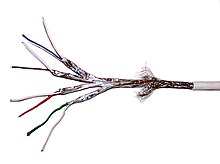Twisted pair cable is all around us. It’s been in our walls since before we were born. And yet most people don’t think about it. That’s kind of interesting since twisted pair and fiber optic cables make almost everything about modern life possible.
The picture above shows is twisted pair cable. It’s just what you would think. There are a lot of cables in a single rubber sheath and they’re wrapped together in pairs. The pairs are twisted so they stay together. It would seem like there’s no more magic to it than that… or is there?
The origins of twisted pair cable
To understand twisted pair cable you have to go all the way back to the days of the telegraph. With a telegraph, you have a pair of wires that go from point to point in what seems like a very simple system today. Back in its day it was totally futuristic, though. The telegraph was real leading edge stuff.
The problem with running telegraph wires is that city planners wanted to use the same poles for electric streetcars. This introduced interference into telegraph lines since the open wires carried so much current and produced a lot of noise. Almost by accident, it was discovered that crossing the wires at every pole solved the problem. The electromagnetic fields of each wire canceled out when they crossed.
Alexander Graham Bell may not have invented the telephone, but he did invent twisted pair cable. Using the same theory as crossing telegraph lines, he discovered that he could run a lot of wires close to each other if the pairs used for each circuit crossed each other. As long as the pairs crossed at different rates (1 twist per inch, 1.5 twists per inch, etc.) interference really went down. That made telephone wiring a lot easier.
Twisted pair in computer networking
Early computer networking used ribbon cables where all the wires were in line, or coaxial cables like TV does now. Both of these methods were slow and wired network speeds in the 1980s hovered around 3 megabits per second. Ribbon cables were delicate and coax cables were expensive. If computer networks were to grow, there had to be a better way.
That solution was 10BaseT. 10BaseT networking used telephone-style wiring to allow for cheap and easy networks. Many offices already had 8-wire twisted pair cables in the walls and it was easy to add more. That’s how computer networks started to use twisted pair wiring.
UTP or STP?
UTP means unshielded twisted pair. In other words, all the wires just sort of hang out together. Because the pairs twist at different rates, there isn’t a lot of interference and you don’t need to add any shielding.

However, in some cases you may choose to use STP, or shielded twisted pair, cable. STP cables use a foil shield or sheath to wrap around each pair. Shielding the pair allows for easier grounding of the cable, which is needed when there’s more current on the line. It also makes the entire cable more resistant to outside interference. Sometimes STP cables will be used for cases where you’re trying to cut down on volatile chemicals since the plastic parts can be thinner and the metal isn’t toxic in a fire.
The best selection of cables
No matter what kind of cable you’re looking for, you’ll find everything you need at Solid Signal!





